Sloping Off - June
2004
The Scorpio Hawker
Hurricane
by Mike Roach
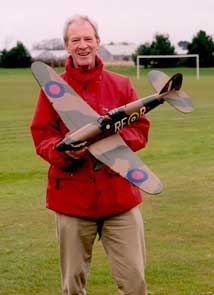 I
was sent this large box by Tony Dowdeswell, which contained a
"shake to assemble" Hurricane, designed in Czechoslovakia,
kitted in Italy and marketed in UK by Mantua Models UK Ltd.
Although advertised at 90 euros, it only costs £49.95 in
UK, which includes the 280 motor, gearbox and a 10 x 7" prop,
an astonishingly good deal. You may have seen it at our
Club bring & buy evening. It is a very impressive 1/12th almost-scale
model of Sgt Josef Frantisek's Battle of Britain aircraft.
He was a Czech who flew with a Polish fighter Squadron in France,
escaped to England and served with 303 (Polish) Squadron RAF,
the highest scoring unit of the time with 126 victories (all of
the pilots had fought 109's over Poland, so were pretty well blooded
in combat compared with our Boys in Blue). Frantisek (DFM
and Bar) scored 17 victories and a probable, was the highest scoring
RAF pilot in the battle, and although he was killed in a landing
accident in this aircraft in 1940, by the end of the war he was
the still the 4th most successful. You can see details 303
Squadron and its pilots at http://ww2-aviation.net/polavhist/303.html.
I
was sent this large box by Tony Dowdeswell, which contained a
"shake to assemble" Hurricane, designed in Czechoslovakia,
kitted in Italy and marketed in UK by Mantua Models UK Ltd.
Although advertised at 90 euros, it only costs £49.95 in
UK, which includes the 280 motor, gearbox and a 10 x 7" prop,
an astonishingly good deal. You may have seen it at our
Club bring & buy evening. It is a very impressive 1/12th almost-scale
model of Sgt Josef Frantisek's Battle of Britain aircraft.
He was a Czech who flew with a Polish fighter Squadron in France,
escaped to England and served with 303 (Polish) Squadron RAF,
the highest scoring unit of the time with 126 victories (all of
the pilots had fought 109's over Poland, so were pretty well blooded
in combat compared with our Boys in Blue). Frantisek (DFM
and Bar) scored 17 victories and a probable, was the highest scoring
RAF pilot in the battle, and although he was killed in a landing
accident in this aircraft in 1940, by the end of the war he was
the still the 4th most successful. You can see details 303
Squadron and its pilots at http://ww2-aviation.net/polavhist/303.html.
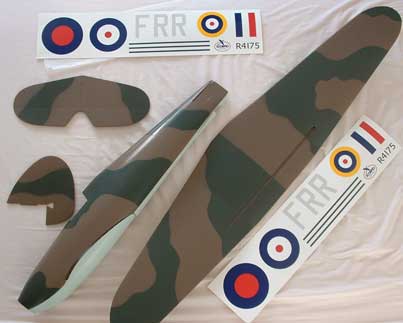 IN
THE BOX
IN
THE BOX
The large and colourful box contains a beautifully made, pre-painted,
pre-joined fuselage, 40" span curved plate wings and flat
plate tail group, all made from a resilient moulded foam (Depron?)
and nearly all the bits you need to get the plane flying are included.
The paint job is a semi-gloss camouflage "Pattern No 1",
accurate for the 1940s and for the aircraft serial number and
Squadron codes included in the very complete transfer set.
The model is easy to assemble and could be completed in less than
a day by a keen adult wanting to get a Hurricane into the air.
Or a keen 14 year-old, I suppose! The main difference between
this Hurricane and the now familiar GWS slow-fliers, and other
fighters in the Scorpio range is that it is designed for rudder/elevator
control and has about 10 degrees dihedral pre-set into each outer
wing panel. This may be an insurmountable barrier to a scale
fan: it looks just like a Heinkel He 100 in the air and severely
compromises the scale appeal, but makes it much easier to fly
than an aileron version. It is marketed as an indoor and
calm outdoor slow flier for beginners and intermediates, modellers
who have successfully flown a glider, perhaps even a powered glider,
and would like something more adventurous but not too much more
difficult to fly. I've skipped all the building guff, because
it's just an ARTF and pretty simple and straightforward to assemble.
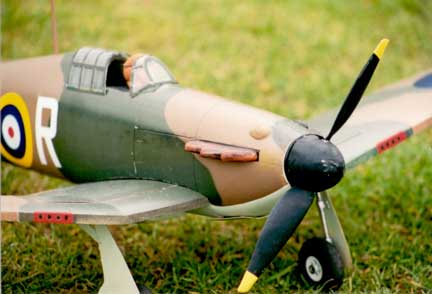 FLYING
FLYING
Don't be tempted, as I was, to fly this model with a smaller prop
than the 10x7". In my haste to get the review done,
I took the "finished" photos with a 9x5" slow fly
prop I had in the spares box and then just had to have a go.
There was enough thrust to fly, but it was all too marginal to
climb away, and it would not take off, but I did establish that
the trims were about right. A couple of days later, with
the designated APC 10x7" "thin electric" prop,
I once more stood on the old cricket pitch at the centre of our
flying field and pushed the throttle right forward into the 5-8
mph breeze. MUCH better! It took off in a couple of
metres and climbed at what looked like a scale angle, the gearbox
rattling away like a can full of nails. It was easy to keep
it flying straight and it turned well with about half rudder and
a fair amount of elevator. At about 30 metres height I reduced
power to 2/3rds, and still it kept climbing, so gradually reduced
to what seemed like 1/3rd throttle for genuine "slow flight".
After a few minutes I climbed again and tried a loop and a roll.
The control movements given on the plan (20 degrees elevator and
30 degrees rudder) are fairly soft, and the loop was a large diameter
affair, with a bit of skewing out at the top. The roll too
was ponderous but I had fun trying. So it flies out of doors,
but I had committed myself to taking it to the Waltham Chase MFC's
Fleming Park 10-court hall. To try and simulate the flight
pattern in a confined space, I made some tight circles left and
right, but was a bit intimidated by the speed relative to my normal
indoor models. 
On the night, my piloting skills were put to the test somewhat,
and after a couple of shaky circuits I misjudged everything and
turned into the wall. There was no damage at all, showing
the unexpected resilience of moulded Depron, so a couple more
attempts were made, but I couldn't keep up enough speed to make
the turns smoothly. I expect to be embarrassed in the future by
Brian's video of the whole proceedings! A beginner would
simply crash it, but an expert should have the confidence to keep
the throttle open and avoid the slow-speed problems I had.
It's really an outdoor slow-flyer at heart, and is far too big
and fast for a beginner to fly indoors, even if his club allows
such "heavy" models in their hall. More flights
have confirmed just how enjoyable it can be to fly this model.
It can rattle past the strip at full throttle "on the deck",
or just potter round a scale circuit at about a third throttle,
while you admire its looks and count the rivets. The stall
is very gentle: it just mushes along with it's nose in the air
and you would have to provoke it really hard to get an adverse
reaction, even with the balance point slightly further back than
advised.
THAT'S IT THEN?
I said at the beginning that the model is aimed at the beginner,
but that it had the makings of a really nice scale aircraft.
Is it a worthwhile buy for a scale fan who wants a slow-fly Hurricane
but has not got the time to build?
First, the model is designed for an all-up-weight of 410 grams/14
oz. The foam parts weigh only 90 grams/3.25 oz and it crossed
my mind that with a GWS geared 150 motor and a 2-cell LiIon pack
(or the twin 150 and a 3-cell pack), the flying weight could be
reduced to 190 grams (6.5 oz), or 220 grams with the more powerful
option. The wing area is 18.8 dm2 (2.1 sq ft) so with the
Speed 280 you have a wing loading of 22 g/dm2 (7 oz/sq ft) and
with the GWS gear, in the order of 11 g/dm2 (3.8 oz/sq ft, and
that's including the undercarriage). At this loading, it
should fly really well indoors, but will not really be a practical
outdoor flyer.
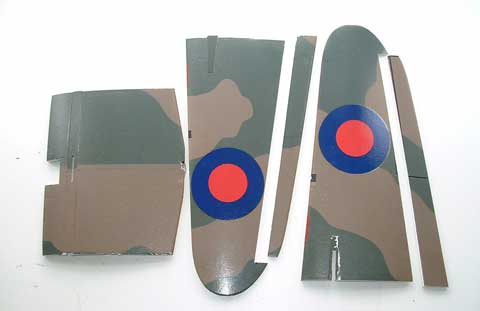 AILERON
FLYING?
AILERON
FLYING?
The next option is to give the model the authentic hunch-shouldered,
"sod-off " look, rather than the somewhat comical gull-wing
and stalky undercarriage of the model. This need not involve
much work on the fuselage, which is a very good likeness, or even
the tail group, but will need a proper aileron wing with just
one degree of dihedral on each panel. The simplest option
is to cut the wing into 3 parts along the dihedral lines, sand
to suit the new shape and epoxy it all back together again.
One of the new "280" outrunners would give it terrific
performance for no weight penalty!
IS IT A SCALE MODEL?
It would make a good Club Night competition, to put the model
on a table with some references, and see how many errors and omissions
were spotted. Good training for scale judges too!
I had a bit of fun making some of the finer details from scraps
of foam: the full-size exhausts, the cylinder-head bulges, carburettor
air-intake and radiator all added less than 10 grams and the radio
aerial (no fighter is complete without an aerial!) is from basswood,
with a piece of foam supporting it inside the fuselage.
But there are still lots of scale details to add, such as wing
fillets, the correct fin/rudder hinge line, a host of fuselage
and wing panel lines, landing lights, cannon/MC guns, and so on.
It would not be too much trouble to add a Volkes filter, sand
off the moulding pips and respray it in those lovely desert camouflage
colours, or the green/grey of the later war years, or all black
as a night fighter, or in Royal Navy colours. Or add a second
wing, for the experimental slip-wing version, or cannon, bombs
or rockets. Or perhaps spray it all-over duck-egg blue for
the prototype!
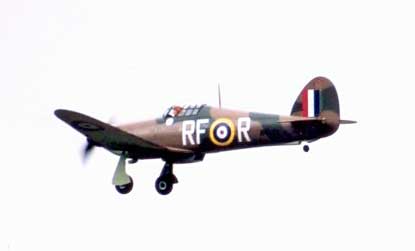 FINALS
FINALS
If you are a beginner, you could certainly make this model, but
I really do not think you could fly it solo without crashing.
With the support of our Club tutors and a buddy box you would
have a lot of fun. If you can fly an electric powered glider
you will be able to fly the Hurricane and if you want a fighter
to beat up Stanpit on a calm evening, but you can only fly rudder/elevator
at the moment, this plane is for you. It assembles into
a large and very pleasing model that when completed seems a bargain
at £49.95, and with just a little more effort with some
foam or balsa and a few dabs of paint it really looks the part.
My concern over the scale fidelity of the wing may be misplaced
and if you buy it to fly, you will not be disappointed, either
with the performance in the air, the look on the ground or the
value for money.
Return to Contents
 I
was sent this large box by Tony Dowdeswell, which contained a
"shake to assemble" Hurricane, designed in Czechoslovakia,
kitted in Italy and marketed in UK by Mantua Models UK Ltd.
Although advertised at 90 euros, it only costs £49.95 in
UK, which includes the 280 motor, gearbox and a 10 x 7" prop,
an astonishingly good deal. You may have seen it at our
Club bring & buy evening. It is a very impressive 1/12th almost-scale
model of Sgt Josef Frantisek's Battle of Britain aircraft.
He was a Czech who flew with a Polish fighter Squadron in France,
escaped to England and served with 303 (Polish) Squadron RAF,
the highest scoring unit of the time with 126 victories (all of
the pilots had fought 109's over Poland, so were pretty well blooded
in combat compared with our Boys in Blue). Frantisek (DFM
and Bar) scored 17 victories and a probable, was the highest scoring
RAF pilot in the battle, and although he was killed in a landing
accident in this aircraft in 1940, by the end of the war he was
the still the 4th most successful. You can see details 303
Squadron and its pilots at http://ww2-aviation.net/polavhist/303.html.
I
was sent this large box by Tony Dowdeswell, which contained a
"shake to assemble" Hurricane, designed in Czechoslovakia,
kitted in Italy and marketed in UK by Mantua Models UK Ltd.
Although advertised at 90 euros, it only costs £49.95 in
UK, which includes the 280 motor, gearbox and a 10 x 7" prop,
an astonishingly good deal. You may have seen it at our
Club bring & buy evening. It is a very impressive 1/12th almost-scale
model of Sgt Josef Frantisek's Battle of Britain aircraft.
He was a Czech who flew with a Polish fighter Squadron in France,
escaped to England and served with 303 (Polish) Squadron RAF,
the highest scoring unit of the time with 126 victories (all of
the pilots had fought 109's over Poland, so were pretty well blooded
in combat compared with our Boys in Blue). Frantisek (DFM
and Bar) scored 17 victories and a probable, was the highest scoring
RAF pilot in the battle, and although he was killed in a landing
accident in this aircraft in 1940, by the end of the war he was
the still the 4th most successful. You can see details 303
Squadron and its pilots at http://ww2-aviation.net/polavhist/303.html. 



